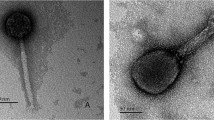Summary
ϰ lI-lysogenic cells of Serratia marcescens as opposed to lI +-lysogenic cells, are receptive to further ϰ infection. After superinfection with wild type or several clear plaque mutants killing and lytic response were observed to a varying extent. From some of the surviving cells doubly lysogenic colonies with a lI + and a lI prophage could originate, lI + being dominant and the cells therefore non-receptive. By this property, combined with a special color reaction, the colonies could be easily screened. Evidence is presented that the lI + gene product probably does not interfere with the formation of new phage receptors but that under its influence receptors are masked.
Two ϰ mutants resembling int- mutants are described which only rarely give double lysogenization and prophage substitution following superinfection. The phage-coded function normally achieving these reactions is likely to work constitutively after superinfection. Transduction experiments performed with one of the two mutants pointed at integration of ϰ prophage into the host DNA near to the trp gene.
Similar content being viewed by others
Abbreviations
- moi:
-
multiplicity of infection
- OD:
-
optical density
- NG:
-
N-methyl-N′-nitro-N-nitrosoguanidine
- NB:
-
nutrient broth
- BS:
-
buffered saline
- EMB:
-
eosmemethylene blue
- leu:
-
leucine
- met:
-
methionine
- pro:
-
proline
- trp:
-
tryptophan
References
Arber, W.: Polylysogeny for bacteriophage λ. Virology 11, 250–272 (1960).
Bauer, G.: Versuche über Transduktion im Kappa-Serratia-System. Dipl.-Arbeit, Univ. Frankfurt a. M. (1970).
Bertani, L. E.: Split-operon control of a prophage gene. Proc. nat. Acad. Sci. (Wash.) 65, 331–336 (1970).
Campbell, A., Zissler, J.: The steric effect in lysogenization by bacteriophage Lambda. III. Superinfection of monolysogenic derivatives of a strain diploid for the prophage attachment site. Virology 28, 659–662 (1966).
Choe, B. K.: Integration defective mutants of bacteriophage P2. Molec. gen. Genet. 105, 275–284 (1969).
Ellmauer, H., Kaplan, R. W.: Auslösung von Klarplaquemutationen durch UV-Bestrahlung des freien Phagen ϰ von Serratia marcescens. Naturwissenschaften 46, 150 (1959).
Gingery, R., Echols, H.: Mutants of bacteriophage λ unable to integrate into the host chromosome. Proc. nat. Acad. Sci. (Wash.) 58, 1507–1514 (1967).
Gottesman, M. E., Yarmolinsky, M. B.: Integration-negative mutants of bacteriophage Lambda. J. molec. Biol. 31, 487–505 (1968).
Lederberg, E. M., Lederberg, J.: Genetic studies of lysogenicity in Escherichia coli. Genetics 38, 51–64 (1953).
Lennox, E. S.: Transduction of linked genetic characters of the host by bacteriophage P1. Virology 1, 190–206 (1955).
Lindahl, G.: Multiple recombination mechanisms in bacteriophage P2. Virology 39, 861–866 (1969).
Losick, R., Robbins, P. W.: The receptor site for a bacterial virus. Sci. Amer. 221 (5), 120–124 (1969).
Pohl, D., Kaplan, R. W.: Einfluß von Bromuracil auf die Mutationsauslösung und Inaktivierung durch UV- und Röntgenstrahlen beim Phagen ϰ. Biophysik 4, 196–213 (1968).
Séchaud, J., Kellenberger, E.: Lyse précoce, provoquée par le chloroforme, chez les bactéries infectées par du bactériophage. Ann. Inst. Pasteur 90, 102–106 (1956).
Smith, H. O.: Defective phage formation by lysogens of integration deficient phage P22 mutants. Virology 34, 203–223 (1968).
Smith, H. O., Levine, M.: A phage P22 gene controlling integration of prophage. Virology 31, 207–216 (1967)
Steiger, H.: Kreuzungs- und mutationsgenetische Untersuchungen an Klarplaquemutanten des Serratiaphagen Kappa. Z. Vererbungsl. 98, 111–126 (1966).
Steiger, H.: Schwach-virulente Mutanten des Phagen Kappa von Serratia marcescens. Z. allg. Mikrobiol. 7, 165–166 (1967).
Steiger, H.: Repressor-defekte mutanten, virulente Mutanten und Adsorptionsresistenz lysogener Zellen beim Phagen ϰ von Serratia. Molec. gen. Genet. 103, 21–28 (1968).
Winkler, U., Kopp-Scholz, U., Haux, Ch.: Nonsense mutants of Serratia phage Kappa. I. Their isolation and use for proving circular linkage of the phage genes. Molec. gen. Genet. 106, 239–253 (1970).
Zissler, J.: Integration-negative (int) mutants of phage λ. Virology 31, 189 (1967).
Author information
Authors and Affiliations
Additional information
Communicated by G. Bertani
Rights and permissions
About this article
Cite this article
Steiger, H., Müller, U. & Bauer, G. Non-receptivity for ϰ phage of ϰ-lysogenic Serratia and reactions to superinfection of receptive cells with a mutant prophage. Molec. Gen. Genet. 114, 358–367 (1972). https://doi.org/10.1007/BF00267504
Received:
Issue Date:
DOI: https://doi.org/10.1007/BF00267504




